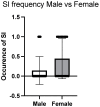Prevalence of Depressive Disorders in Operatively Treated Pelvic Trauma Patients
- PMID: 40277816
- PMCID: PMC12026098
- DOI: 10.3390/diseases13040105
Prevalence of Depressive Disorders in Operatively Treated Pelvic Trauma Patients
Abstract
Aim: The aim of this study is to assess the prevalence of depressive disorders in patients with pelvic fractures treated surgically at our center in the years 2017-2022.
Materials and methods: The study included 75 patients, 57 men and 18 women, operated on in our center in the years 2017-2022 due to acetabular fracture and pelvic ring injury. Factors such as age, gender, chronic pain measured with the VAS scale, and the incidence of suicidal thoughts were also analyzed. The participants completed the Beck Depression Inventory (BDI).
Results: Thirty-five out of the seventy-five patients showed symptoms of depression (BDI score > 11), which is 47%, with an average score of 29 (p < 0.0001). Women obtained an average BDI score of 23, which corresponds to moderate depression on Beck's scale (p < 0.008). The correlation between BDI score and chronic pain in pelvic trauma patients has been found to be positive (p < 0.0003; r = 0.4094). Furthermore, women in our studied population reported suicidal thoughts more often than men (44% vs. 14%; p < 0.01). No statistically significant correlation was found between the occurrence of depression and the length of hospital stay and the patient's age (p < 0.5 and p < 0.06, respectively).
Conclusions: The prevalence of depression in the pelvic trauma patients of the studied population has been determined to be 47%.
Keywords: acetabulum; depression; fracture; pelvis; suicidal ideation.
Conflict of interest statement
The authors declare no conflict of interest.
Figures









Similar articles
-
[Correlations between Beck's suicidal ideation scale, suicidal risk assessment scale RSD and Hamilton's depression rating scale].Encephale. 2008 Apr;34(2):132-8. doi: 10.1016/j.encep.2006.09.002. Epub 2007 Nov 26. Encephale. 2008. PMID: 18597720 French.
-
Depression and suicidal ideation among the geriatric population of Kashmir, India.Int J Soc Psychiatry. 2021 Sep;67(6):651-655. doi: 10.1177/0020764020968592. Epub 2020 Oct 24. Int J Soc Psychiatry. 2021. PMID: 33100095
-
Depression and suicidal thoughts in untreated and treated narcolepsy: Systematic analysis.Neurology. 2020 Nov 17;95(20):e2755-e2768. doi: 10.1212/WNL.0000000000010737. Epub 2020 Sep 22. Neurology. 2020. PMID: 32963102
-
[Multicentric study of patients with pelvic injury: basic analysis of the study group].Acta Chir Orthop Traumatol Cech. 2009 Oct;76(5):404-9. Acta Chir Orthop Traumatol Cech. 2009. PMID: 19912705 Czech.
-
Predictors of suicidal ideation in people with epilepsy living in Korea.J Clin Neurol. 2010 Jun;6(2):81-8. doi: 10.3988/jcn.2010.6.2.81. Epub 2010 Jun 30. J Clin Neurol. 2010. PMID: 20607047 Free PMC article.
References
-
- Depressive Disorder (Depression) [(accessed on 18 October 2024)]. Available online: https://www.who.int/news-room/fact-sheets/detail/depression.
-
- Pitsillou E., Bresnehan S.M., Kagarakis E.A., Wijoyo S.J., Liang J., Hung A., Karagiannis T.C. The cellular and molecular basis of major depressive disorder: Towards a unified model for understanding clinical depression. Mol. Biol. Rep. 2020;47:753–770. doi: 10.1007/s11033-019-05129-3. - DOI - PubMed
LinkOut - more resources
Full Text Sources

